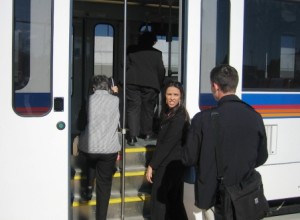We have much more to do and your continued support is needed now more than ever.
Riding the Rails to Carbon Neutrality

Commuter carbon emissions reductions
The University of Denver’s goals for reducing its overall energy consumption will involve improvements in HVAC and lighting systems as well as other building upgrades, but the school is also on a journey to reduce its emissions through more efficient travel. Although most University of Denver (DU) students live on or near campus–within a 20 minute walking distance–many go off campus for work and social activities. Two thousand staff and faculty also make the daily commute to campus.
Using the Clean Air Cool Planet calculator, DU estimated its total commuting emissions at 9,106 metric tons of CO2e (carbon dioxide equivalent) in 2007. That was a full 96 percent of the overall transportation-related emissions, which makes up approximately 14 percent of the school’s overall greenhouse gas emissions that year.
Long before the school started addressing climate change, DU students wanted better transportation options, and in 2001 voted to charge a mandatory $35/quarter fee (unsubsidized by DU) to full-time undergraduates for an all-access public transportation Eco Pass. In 2002, the university decided to pick up the Eco Pass tab for staff and faculty to encourage their use of public transit.
But it wasn’t until the opening of a new light rail station on campus in 2007 that interest in the program really increased. Graduate students and law students wanted to have the same access as undergrads, so both added the mandatory charge to their quarterly fees. Comparing the first two years (05/06 to 06/07), there was an increase of Eco Pass pick-ups of 78 percent (undergraduate and law students only), with an additional boost of 26 percent the year following.
Since the station’s opening, a 20-hour per day shuttle service that transports people from the light rail station to other points on campus has further boosted interest in light rail usage.
Financial paybacks of increased ridership
The benefits of light rail for universities aren’t just individual. The financial costs of building and maintaining parking lots are often significantly higher than supporting light rail ridership.
On December 28, 2008, Arizona State University (ASU) started reaping the benefits of having two light rail stations connecting its Tempe campus to the rest of the city. Working closely with Valley Metro, ASU provided the land for both stops and was closely involved in planning how feeder lines would work in order to ensure easy access for students. “ASU and Valley Metro are so embedded with each other, especially since ASU accounts for close to 20 percent of Valley Metro’s ridership,” comments Bonny Bentzin, ASU’s director of university sustainability practices. “We work closely together on these types of projects.”
Although final figures on light rail usage since the stations’ openings haven’t yet been gathered, the initial numbers are encouraging. The office of sustainability has seen a jump of nearly 45 percent overall in the number of passes issued in January/February 2009, when compared to the same period in 2008. With over 26,000 of the 67,000 students attending classes, that’s nearly 40 percent participation in the program. And unlike DU’s abundance of on-campus housing, at ASU there are only 7,200 beds on campus, which means many are using the light rail system to commute to and from campus and to work as well.
Faculty and staff also have the opportunity to take advantage of the new transportation convenience. They pay an average of $20/month–a paltry fee compared to the $210/year to $780/year fee for parking.
And since the opening of the new light rail stations, ASU has seen a significant decrease in demand for parking. In fact, demand has dropped so far that the school has shelved a $30 million parking garage/office building project.
Savings in parking costs are common for institutions and companies that choose to encourage public transit over solo driving. One estimate puts the initial construction costs of one parking space anywhere between $2,000 and $12,000 (many estimates are much higher), with annual operational expenses around 1.5 percent of the up-front capital costs ($30 to $180 by these approximations).
And as Denver University has discovered, having too much costly parking can hurt efforts to reduce commuter carbon emissions. Ten years ago, DU consulted with staff, faculty, students, and local area residents, determining that more parking was needed, and has since increased its available parking from less than 2,500 spaces to 5,000 spaces.

Faculty and staff have also come out in higher numbers to use public transit. Some of the staff have even formed a Commute Club that tracks the carbon dioxide savings they’ve accumulated using public transit: a grand total of over 350,000 pounds of CO2 emissions between 2005 and 2007, with 996,720 miles of alternate modes of transportation reported.
Spreading the word
ASU has a goal of becoming carbon neutral by 2020 and although it isn’t yet clear how much student, staff, and faculty commuting will factor into the overall goal, early indications suggest that it will play a part.
And news has spread about the effectiveness of the program. Word is that ARAMARK, employing 400 people on the ASU campus, is considering offering a similar bus pass benefit for their staff.
People like light rail, but will it be enough to make public transit a routine alternative to solo driving? To make a significant dent in a school’s carbon emissions? It’s hard to say. As Neil Krauss, DU Assistant Vice Chancellor for Business and Financial Affairs pointed out, “People like to use their cars.”




















